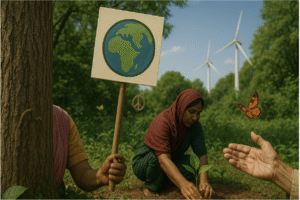The signs of climate disruption in cities are no longer abstract. We have seen how Bengaluru experiences this crisis; unevenly, and often through gaps in governance, funding, and execution. We’ve also been familiar with how climate action hinges not just on what’s planned, but on who carries it, and how long they stay with it.
There is also another layer to the story; the actors who don’t sit within the government but often move the needle just as much.
Earlier this year, I sat through two kinds of climate review meetings. The first was with city officials, sharp, structured, bound by time and mandate. The second was with non-state partners: NGOs, researchers, and citizen groups. The difference was striking. The latter felt like a writeshop, not a checklist.
What emerged in that room wasn’t just feedback, it was possibility. Where one meeting tallied what had been done, the other imagined what could be. The ideas weren’t bound to job descriptions or election cycles. They stretched wider, stayed longer, and sometimes dug deeper.
That difference isn’t accidental. In Bengaluru, this “other side” of climate action, driven by non-state actors, is not just visible, it’s organised. Bengaluru has a living, breathing network of people, research institutions, NGOs, and even corporates working together in Friends of Climate Action Cell, a unique ecosystem hosted by the Bengaluru Climate Action Cell. In most cities, the government leads and others follow. Here, collaboration isn’t just a footnote—it’s often the lever that moves the work.
In Bengaluru, it’s not unusual for citizen groups to influence ward-level decisions or for academic institutions to sit in on strategy rounds. This is not just outreach; it’s co-production.
That kind of co-production matters. At one point, the city wanted to design dynamic, hyperlocal climate profiles across wards. While official tools remained static and generic, an NGO had already developed adaptive formats in one ward, formats that evolved with season, feedback, and community insight. When the two approaches aligned, the result was not only smarter but also more durable.
This is where the trade-off lies. State actors bring scale, resources, and authority. Non-state actors bring adaptability, continuity, and trust. When we try to separate the two, we miss the point. The strength lies in how they meet.
Nowhere is this more important than in climate work. Because the crisis is both structural and intimate. It needs the command of city plans and the compassion of citizen response. It needs policy, but it also needs presence.
And while collaboration always brings friction, on pace, on protocol, on who gets to decide, when done right, it does more than fill gaps. It closes the distance between paper and people.
This isn’t about adding new actors to a table. It’s about recognising that in a city like Bengaluru, the table has already been laid by many hands. The question is not whether to invite them in. The question is whether we listen when they speak.
Because climate action isn’t made whole by scale or speed alone. Sometimes, it’s made better by listening to those who never stopped acting.


